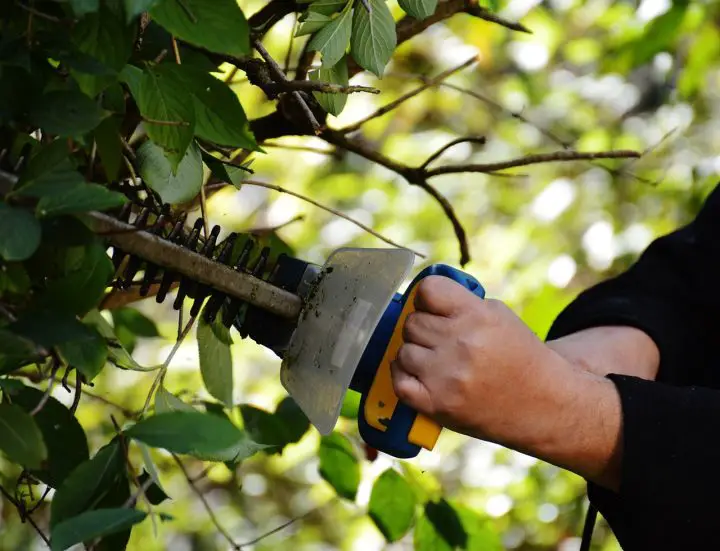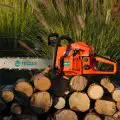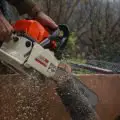When it comes to pruning trees and bushes, you have several tools to choose from. Two of the most popular options are the hedge trimmer and the chainsaw. Both of these tools have their strengths and weaknesses, and which one you choose will depend on the task at hand.
In this article, we will explore the differences between a hedge trimmer vs chainsaw, and help you decide which tool is best suited for your needs.

Table of Contents
- What is a Hedge Trimmer?
- What is a Chainsaw?
- Chainsaw vs Hedge Trimmer: Which Is Better?
- How to Choose Which One You Need
- Do You Need Both a Chainsaw and a Hedge Trimmer?
- Can I Use One for the Other?
- Chainsaw vs Pole Saw vs Hedge Trimmer
- Chainsaw and Hedge Trimmer are Both Important
- FAQs (Frequently Asked Questions)
Let’s take a closer look at each tool.
What is a Hedge Trimmer?
A hedge trimmer is a great tool for trimming hedges and bushes. It is designed to make clean, precise cuts, making it ideal for shaping and maintaining the appearance of your landscaping.
Hedge trimmers come in two different types: electric and gas-powered.
- Electric hedge trimmers are quieter and easier to maintain than gas-powered trimmers. They are also lighter and more maneuverable, making them ideal for detailed work. However, electric hedge trimmers are not as powerful as their gas-powered counterparts, so they may struggle to cut through thicker branches.
- Gas-powered hedge trimmers, on the other hand, are more powerful and can handle thicker branches with ease. They are also more portable, as they don’t require a power source. However, gas-powered hedge trimmers are heavier and more difficult to maneuver, so they may not be the best choice for detailed work.
- The electric edge trimmer features 17-inch dual-action hardened steel blade for reduced vibration while trimming (Compared to BLACK plus DECKER single-action blade models)
- 3.2 amp motor for trimming branches up to 5/8 inch
- Lightweight, compact design of the trimmers for plants is easy to use with less fatigue
- Cord retention prevents accidental unplugging. Cutting Strokes/Min-3800
- Built-in T-handle and full-length trigger for control while cutt
Prices pulled from the Amazon Product Advertising API on:
Product prices and availability are accurate as of the date/time indicated and are subject to change. Any price and availability information displayed on [relevant Amazon Site(s), as applicable] at the time of purchase will apply to the purchase of this product.
What is a Chainsaw?
A chainsaw is a powerful tool that can handle a wide range of tasks. It is ideal for cutting down trees, large limbs, and thick branches.
Chainsaws come in two different types: gas-powered and electric.
- Gas-powered chainsaws are more powerful than electric chainsaws, making them ideal for heavy-duty tasks. They are also more portable, as they don’t require a power source. However, gas-powered chainsaws are heavier and more difficult to maneuver, making them less ideal for detailed work.
- Electric chainsaws, on the other hand, are lighter and more maneuverable than gas-powered chainsaws. They are also quieter and easier to maintain. However, electric chainsaws are not as powerful as gas-powered chainsaws, so they may struggle with heavy-duty tasks.
You can learn more about the different types of chainsaws in our guide, along with a comparison of electric vs gas chainsaws!
- Husqvarna 135 Mark II 16 inch chainsaw is robust, reliable and easy to use, making it a valuable tool for a variety of home and garden tasks—recommended for use with bar lengths between 14 inches (min) and 16 inches (max)
- Effortless Start-Up: Smart Start allows this Husqvarna chainsaw to quickly and easily start up with minimal effort, while the gas chainsaw 16 inch blade has an inertia-activated chain brake reduces the likelihood of injury due to kickback
- Powerful and Efficient: Gas powered chainsaw with a 38-cc, 2.1-HP X-Torq engine that reduces emissions (up to 60%) and increases fuel efficiency (up to 20%), while combined choke/stop control helps reduce the risk of engine flooding
- Air Injection Technology: Chainsaws equipped with a centrifugal air cleaning system that expels larger dust and debris particles before they reach the air filter for improved engine life
- Easy Adjustments and Handling: Features a side-mounted tensioning system positioned for easy slack adjustments and LowVib technology that uses dampeners to reduce vibrations for easier handling of recommended 14 to 16-inch chainsaw b
Prices pulled from the Amazon Product Advertising API on:
Product prices and availability are accurate as of the date/time indicated and are subject to change. Any price and availability information displayed on [relevant Amazon Site(s), as applicable] at the time of purchase will apply to the purchase of this product.
Chainsaw vs Hedge Trimmer: Which Is Better?
| Chainsaw | Hedge Trimmer | |
|---|---|---|
| Best for | Cutting down trees, trimming large branches, and sawing through thick wood. | Shaping and maintaining hedges, bushes, and other smaller, leafier vegetation. |
| Power | Generally more powerful than hedge trimmers, capable of handling larger, tougher jobs. | Less powerful than chainsaws but perfectly suited for smaller, more delicate tasks. |
| Cutting Capacity | Can cut through thick branches and trunks, typically anything over 2 inches in diameter. | Ideal for branches typically up to 3/4 inch thick, depending on the model. |
| Precision | Less precise compared to hedge trimmers; not ideal for detailed shaping. | Offers more control and precision for shaping and trimming hedges and bushes. |
| Safety | Requires more safety precautions due to the potential for serious injury. | Generally safer than chainsaws, but still requires proper safety gear and precautions. |
When it comes to pruning, a hedge trimmer vs chainsaw both have their advantages and disadvantages.
In short, a chainsaw is a powerful tool that is typically used for cutting down trees, branches, and large limbs. It is a versatile tool that can handle a wide range of tasks, but it requires more skill and experience to know how to use a chainsaw safely.
On the other hand, a hedge trimmer is a tool that is specifically designed for trimming hedges and shrubs. It is a lighter and more maneuverable tool, making it ideal for detailed work.
Which Should I Use for Cutting?
A chainsaw is your go-to tool for handling larger, more robust cutting jobs, such as felling trees or slicing through thick branches. Its powerful motor and larger blade make it suited for cutting through materials that are typically over 2 inches in diameter, offering the strength needed for substantial tasks. However, it lacks the precision required for more delicate work, such as shaping and detailed trimming, and demands stringent safety measures due to its potential for causing serious injuries.
On the other hand, a hedge trimmer is designed for more refined tasks. It excels in shaping and maintaining hedges, bushes, and smaller vegetation, providing the control and precision needed for detailed landscaping efforts. Hedge trimmers are ideal for cutting thinner branches, usually up to 3/4 inch thick, making them unsuitable for the heavy-duty work chainsaws are built for. They are generally safer and more user-friendly than chainsaws, though proper safety gear and precautions are still essential.
Ultimately, the decision between using a chainsaw or a hedge trimmer boils down to the specifics of the cutting task at hand. For large-scale, tough cutting jobs requiring power over precision, a chainsaw is the appropriate choice. Conversely, for tasks demanding finesse, such as trimming and shaping hedges or dealing with smaller branches, a hedge trimmer will serve you best.
Evaluating the size, type of vegetation, and the level of detail required for your project will guide you to the most suitable tool, ensuring both efficiency and safety in your cutting tasks.
Which Shall I Use for Pruning?
When it comes to pruning, both pruning chainsaws and hedge trimmers have their advantages and disadvantages. A pruning chainsaw is better suited for cutting thicker branches and trees, while a hedge trimmer is designed for shaping and trimming hedges and bushes.
A pruning chainsaw is a chainsaw that is specifically designed for pruning trees and shrubs. It is smaller and lighter than a regular chainsaw, making it easier to maneuver in tight spaces. Pruning chainsaws also have smaller guide bars and chains, making them ideal for precise cuts.
If you need to prune thicker branches or trees, a pruning chainsaw is the better choice. However, if you need to shape and trim hedges and bushes, a hedge trimmer is the better option. Ultimately, the choice between a pruning chainsaw and a hedge trimmer depends on the type of pruning you need to do.
Learn more about pruning, felling, and cutting trees in our following guides:
- Cutting Down Dead Trees
- How to Cut Down a Tall Tree by Yourself
- How to Cut a Leaning Tree in the Opposite Direction
- How to Cut a Palm Tree Down
Which Should I Use for Trimming?
A hedge trimmer is generally the more appropriate tool to use. Hedge trimmers are designed specifically for precision work and are excellent for shaping and maintaining foliage with a level of finesness that chainsaws simply cannot match. They allow for cleaner cuts on smaller branches and leaves, making them ideal for detailed landscaping work.
Chainsaws, on the other hand, are powerful tools best suited for cutting down trees and slicing through thick branches. They lack the precision required for trimming and shaping hedges and could easily damage or destroy the vegetation you’re trying to maintain. Additionally, the use of a chainsaw for such delicate tasks poses unnecessary safety risks.
How to Choose Which One You Need
Here’s a guide to help you decide:
Understanding the Nature of Your Task
- Type of Vegetation: If you’re dealing with thick wood, such as tree trunks or large branches typically over 2 inches in diameter, a chainsaw is necessary for its power and capacity to cut through such materials. Conversely, if your task involves maintaining or shaping hedges, bushes, or cutting smaller branches (usually up to 3/4 inch thick), a hedge trimmer is designed for this kind of precision work.
- Task Objective: Consider what you aim to achieve. If the goal is to fell trees, cut up firewood, or manage large-scale clearing, the chainsaw emerges as the clear choice due to its robust capabilities. For tasks that require finesse, such as shaping and detailed trimming of foliage to enhance your garden’s aesthetic appeal, the hedge trimmer excels.
- Precision vs. Power: Chainsaws offer significant power but lack the precision for delicate trimming and shaping. Hedge trimmers, while less powerful, provide greater control and accuracy, making them ideal for detailed landscaping tasks.
Evaluating Your Requirements
- Safety and Handling: Chainsaws demand respect and strict adherence to safety protocols due to their potential for causing serious injuries. If your task can be accomplished with a hedge trimmer, which is generally safer and easier to handle, it may be the wiser choice.
- Experience and Comfort Level: Consider your experience and comfort level with each tool. Chainsaws require a higher level of expertise and confidence to operate safely. If your task doesn’t necessitate the raw power of a chainsaw, opting for a hedge trimmer might be more appropriate and safer, especially for casual or inexperienced users.
- Future Needs: Think about future tasks in your garden or property. Investing in a tool that can serve multiple purposes or address future needs might be more cost-effective in the long run. If you anticipate dealing with larger trees or branches down the line, a chainsaw could be a valuable asset. For regular maintenance of hedges and bushes, a hedge trimmer will likely suffice.
Making the Decision
Choosing between a chainsaw and a hedge trimmer ultimately comes down to the specific requirements of your task — the size and type of vegetation you’re dealing with, the precision needed for the job, and your personal safety and comfort with the tool.
Do You Need Both a Chainsaw and a Hedge Trimmer?
It depends on the range of gardening and landscaping tasks you plan to undertake. Each tool serves distinct purposes and excels in different scenarios, making them complementary rather than interchangeable for many homeowners and professionals.
Diverse Landscaping Needs
- Variety of Vegetation: If your property includes a mix of thick trees and delicate shrubbery, having both tools allows you to manage this diversity effectively. The chainsaw can handle the heavy-duty work of cutting down trees and managing large branches, while the hedge trimmer is ideal for regular maintenance of hedges and bushes, ensuring they are neat and well-shaped.
Precision and Power
- Task-Specific Tools: For precision work such as shaping and trimming hedges, a hedge trimmer is necessary for its accuracy and ability to create clean lines and shapes. On the other hand, the power of a chainsaw is indispensable for tasks that involve cutting through thick wood, where brute force is required.
Safety and Efficiency
- Appropriate Tool for Each Job: Using the right tool for each task not only ensures efficiency but also safety. A chainsaw, while powerful, is not suited for delicate trimming tasks and could pose a safety risk if used improperly. Similarly, attempting to cut a thick branch or tree with a hedge trimmer is ineffective and could damage the tool.
Cost-Effectiveness
- Long-Term Investment: For those with ongoing landscaping needs, investing in both tools can be cost-effective in the long run. It allows for proper care and maintenance of your property, potentially saving money on professional services for tasks you can safely complete yourself.
While it might not be necessary for everyone, particularly those with either very minimal landscaping requirements or properties that don’t feature a mix of thick trees and delicate foliage, for those who encounter a range of gardening tasks, having both tools ensures you’re equipped to handle anything from routine trimming to more substantial cutting tasks safely and efficiently.
Can I Use One for the Other?
Can I Use a Chainsaw Instead of a Hedge Trimmer?
Using a chainsaw instead of a hedge trimmer is generally not recommended for tasks typically suited to a hedge trimmer, such as trimming hedges or shaping bushes.
For most hedge and bush maintenance tasks, a hedge trimmer is the appropriate and safe choice. It is designed specifically for these types of gardening jobs, offering the precision, safety, and plant health benefits that a chainsaw cannot match.
Can I Use a Hedge Trimmer Instead of a Chainsaw?
Opting for a hedge trimmer instead of a chainsaw for tasks typically suited to a chainsaw is generally not advisable and can be ineffective or even dangerous, depending on the task.
While it might be tempting to use a hedge trimmer for tasks typically reserved for a chainsaw, especially if you do not have access to a chainsaw, it’s important to use each tool according to its designed purpose. Doing so ensures safety, efficiency, and the longevity of your tools, while also providing the best care for your garden or yard. For heavy-duty cutting tasks, investing in or renting a chainsaw is the recommended approach.
Chainsaw vs Pole Saw vs Hedge Trimmer
In addition to hedge trimmers and chainsaws, pole saws are another option for pruning trees and bushes. Pole saws are essentially chainsaws on a long pole, allowing you to reach high branches without having to use a ladder. Like hedge trimmers and chainsaws, pole saws come in gas-powered and electric models.
Gas-powered pole saws are more powerful than electric pole saws, making them better suited for heavy-duty tasks. However, they are heavier and more difficult to maneuver, so they may not be the best choice for detailed work.
Electric pole saws are lighter and more maneuverable than gas-powered pole saws. They are also quieter and easier to maintain. However, electric pole saws are not as powerful as gas-powered pole saws, so they may struggle with thicker branches.
Learn how to use a pole saw in our step-by-step guide!
Ultimately, the choice of tool depends on the specific job you need to do:
- If you need to shape and trim hedges and small bushes, a hedge trimmer is the best choice.
- If you need to cut down thick branches or trees, a chainsaw is the tool for the job.
- If you need to prune high branches, a pole saw is a good option.
Chainsaw and Hedge Trimmer are Both Important
In summary, when it comes to pruning trees and bushes, there are several tools to choose from. Hedge trimmers, chainsaws, and pole saws are all popular options, each with its own strengths and weaknesses.
When choosing a tool, consider the type of pruning you need to do, the size of the branches you’ll be cutting, and your level of experience with the tool. With the right tool and a little bit of practice, you can keep your landscaping looking its best all year round.
FAQs (Frequently Asked Questions)
Should I use a hedge trimmer or a chainsaw?
The choice between a hedge trimmer and a chainsaw depends on the type of job you need to do. Hedge trimmers are best suited for shaping and trimming hedges, bushes, and small trees. Chainsaws, on the other hand, are better suited for cutting thicker branches and trees. If you need to shape and trim a hedge, a hedge trimmer is the best choice. If you need to cut down a tree or thick branches, a chainsaw is the tool for the job.
Can you use chainsaw for hedge trimming?
While it is possible to use a chainsaw for hedge trimming, it is not the most efficient or effective tool for the job. Chainsaws are designed to cut thick branches and trees, not delicate hedges and bushes. Using a chainsaw for hedge trimming can result in uneven cuts and damage to the plant. Hedge trimmers are specifically designed for shaping and trimming hedges and are the best tool for the job.
Can I use hedge trimmer to cut tree branches?
Hedge trimmers are not designed to cut thick tree branches. They are designed to shape and trim hedges and bushes. Attempting to use a hedge trimmer to cut tree branches can result in damage to the tool or injury to the operator. For cutting thicker branches or trees, a chainsaw or pole saw is a better option.
Are hedge trimmers worth it?
Hedge trimmers are a worthwhile investment for anyone who wants to maintain the appearance of their landscaping. They make shaping and trimming hedges and bushes a quick and easy task. Hedge trimmers come in a range of models and prices, from basic electric models to high-end gas-powered models. For homeowners who have hedges or bushes on their property, a hedge trimmer is a worthwhile investment that can save time and effort in maintaining the appearance of their landscaping.






